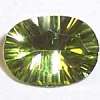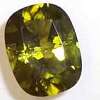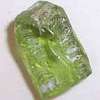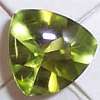
Peridot is one of those cases where an old gem has survived but has become attached to a different gem. In this particular case, the long-time known gem originates from the island of Zebirget (St. John’s) in the Red Sea under the Olivine gem type. Characterized by its particular color and vitreous luster, Peridot is the greener type of Olivine, while the yellower type is Chrysolite. Much appreciated in the past, Olivine has become the victim of changing fashions and is far less highly prized today. Peridot was at its peak of popularity during the Middle Ages when the crusaders brought it to Central Europe and it was used for ecclesiastical purposes. It was also the most popular gem during the Baroque period, which may be interesting to some of you gem historians out there.
As I mentioned earlier, there are two different color schemes that Peridot come in. What many people don’t know is that some of the finest-colored Peridot in the world comes from Arizona. While many have a stigma about Arizona
Peridot being too dark or appearing “dirty,” I was surprised to learn that many Peridot we see with the perfect color blend come from Arizona. In fact, Arizona material can often times rival what is considered the finest Pakistan material. These rich-colored gems from Pakistan and Arizona, especially in larger sizes, are very hard to find. On the other end of the spectrum, there are the more common yellow-green Peridot that predominantly come from China. These brighter, lighter Peridot are the most sought after variety for the birthstone for August.
As far as pricing goes, Peridot is a little unusual compared to the pricing trends for other common gems like Amethyst and Citrine. The price per carat remains relatively consistent up to two carats. Once we pass the two carat point, the price increases rapidly.





